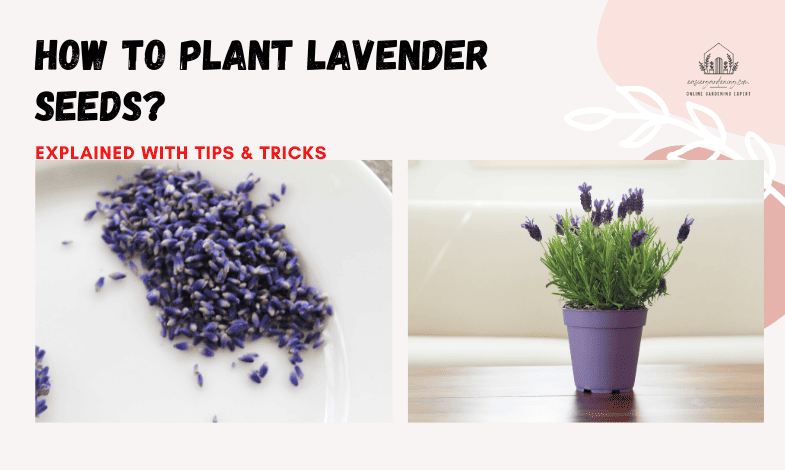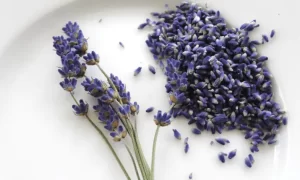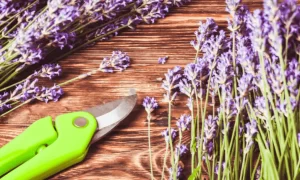How to Plant Lavender Seeds: Lavender Planting by cuttings, sowing & division: The lavender genus (Lavandula) includes many different species and varieties. However, all of them are propagated similarly. This is because, contrary to what many people think, lavender is not a perennial, but a semi-shrub. As such, lavender naturally becomes woody with age. Therefore, sooner or later you should rejuvenate your stock to benefit from the fragrant flowers for as long as possible. Lavender can be propagated in several ways. Whether by cuttings, sowing, or division – we reveal which method is best suited.
Below, we present three popular methods for propagating lavender along with a detailed overview on how to plant lavender seeds. We have also compiled general information about lavender for you here.
Read more about How to plant cherry seeds?
Contents
- How to Plant Lavender Seeds: Best Ways to Plant Lavender
- Propagating Lavender by sowing
- Use only mature seeds
- Lavender is a light germinator
- Sowing lavender seeds
- Propagating lavender via cuttings
- Propagate lavender by division
- Final Thoughts: How to Plant Lavender Seeds?
- How long do lavender plants take to grow from seed?
- Does lavender grow back every year?
- Where should I plant lavender in my garden?
How to Plant Lavender Seeds: Best Ways to Plant Lavender
To be honest, the best way to plant lavender (Lavandula angustifolia, or Lavandula stoechas) is the propagation of cuttings. In principle, sowing is also possible, but this is very time-consuming and involves a lot of work.
Propagating Lavender by sowing
If you are here to know how to plant lavender seeds, this is the part for you. Read carefully. Although lavender seeds are available in the trade, they are usually not of a single variety. Therefore, the plants from a seed packet may look different. This is not a problem with individual shrubs, but it is much more unpleasant if several plants are to grow next to each other – for example, as a hedge or bed border. In this case, it is best to grow the young plants in a separate bed and sort them out after a year.
Use only mature seeds
Lavender seeds, unlike the plants, you can prepare on the windowsill or in the greenhouse already from February / March. However, in the open field, the seed should be planted only when frosts are no longer expected. This applies in particular to the sensitive Schopflavendel, which should not be cultivated anyway better in the open field. In the trade, you can usually only get seeds of the so-called “wild lavender”, by which is meant the true lavender. This seed-bearing variety is the easiest to propagate by seed, with all others the method does not work so well.
Tips: The best way to germinate lavender seeds is to stratify them beforehand, that is, expose them to a prolonged period of cold weather.
However, this measure is not strictly necessary, because you can sow the fine grains in this way. Stratification increases the likelihood of success. And this is how you proceed:
- Take a resealable (say, zip-lock) freezer bag and some (little) sand.
- Slightly moisten the sand and fill it into the bag.
- Now place the seeds on top of the sand.
- Seal the bag and place it in the vegetable compartment in the refrigerator.
- The seeds should store there for about one to two weeks.
- Then fill growing pots with growing soil and simply pack the sand with the seeds on top. Do not cover with cling film, because lavender does not tolerate high humidity very well.
Lavender is a light germinator
Gardeners generally distinguish between dark and light germinators. Light germinating varieties are best brought to a bright location, and also, if possible, should not be covered with soil. Instead, it is sufficient to press the fine seeds lightly against the previously moistened soil, for example with aboard. Keep the seeds evenly moist, which works wonderfully with a spray bottle. Light sprouts tend to have very fine seeds that are quickly washed away when watered.
Sowing lavender seeds
First of all, you need to know how to plant lavender seeds properly. Lavender plants grown from seed are rarely true to variety, meaning they differ, sometimes considerably, in the color and shape of their leaves, in growth habit and height, and sometimes in the color of their flowers. If you want plants that look alike, it is better to resort to cuttings propagation. Planting seeds is done in this way:
- Plants pre-pulled in February / March usually bloom in the same year.
- Use low-nutrient growing or herbal soil, preferably germ-free.
- Fill this substrate into growing pots or an indoor greenhouse.
- Moisten the soil before sowing the seeds.
- Place the seeds on the soil and cover them only very lightly with soil.
- Be sure to keep the humidity low – no drips should form in the greenhouse.
- The seedlings need a bright place as well as temperatures around 20 °C.
- Germination occurs after one to two weeks but can take much longer.
Tips: You can prick the seedlings and plant them at least five centimeters apart as soon as the first leaflets appear after the cotyledons. Shorten the roots a little with clean nail scissors, then they will branch better.
Propagating lavender via cuttings
If you don’t want to go through the trouble of sowing lavender seeds, you can simply clone your existing plant via cuttings. Planting lavender via cuttings is the best way. This method is also known as vegetative propagation. To obtain cuttings, you can use, for example, the cuttings that occur when pruning in the spring. To do this, cut young shoots into pieces about 15 cm long with a clean, sharp knife.
Then strip off the lower leaves of the branch and place the cuttings about 10 cm deep in the nutrient-poor substrate. Ideally suited is a peat-free growing soil such as our Organic Herb & Seeding Soil. The soil should always be kept moist without the plant sinking into waterlogging. As a rule, the first roots will form after a few weeks and the small plants can be planted individually in pots.
Cuttings you can basically put all year round. Cuttings that are planted in spring (end of March) can be transplanted into the open at the latest after the Ice Saints in May. However, if you want to plant out your lavender cuttings in late summer or fall, be sure to protect them from the winter.
Tips: Woody parts of the lavender plant are no longer suitable for propagation via cuttings.
Propagate lavender by division
Propagate lavender by division is another way to plant lavender. Perennial plants, of which lavender is one, can usually be propagated quite easily by root division. To do this, lift the root ball with a spade in spring (March/April) or fall (September) and divide it into two pieces. Then plant the pieces again at a sufficient distance from each other. However, it should not be planted too densely, so that the lavender plants still have enough space to grow.
Dividing a lavender bush, however, is only possible if it has rooted in several places in the ground. Unfortunately, the severe woodiness of older plants often makes the process even more difficult. The wounds of woody areas caused by dividing are also favorable entry points for undesirable diseases. Therefore, propagation by cuttings is much more suitable for most species of lavender.
Learn more about How to plant peach seeds?
Final Thoughts: How to Plant Lavender Seeds?
When you are here to know how to plant lavender seeds, we must warn you that, propagation by the seed of lavender is usually difficult. Because special conditions are necessary for germination and growth. Lavender is a light germinator, which means that the seeds should only be lightly covered with soil. The germination period is about one to two weeks in optimal conditions, but can sometimes stretch over a few months.
Frequently Asked Questions
How long do lavender plants take to grow from seed?
The seeds can take 15 days to a month to germinate. You can accelerate the germination process by placing the seeds in a warm spot.
Does lavender grow back every year?
Yes, because lavender is a perennial plant. So it will certainly come back to your garden every year for at least 3-5 years
Where should I plant lavender in my garden?
To successfully harvest lavender plants, you should plant them in an area that is well-drained gets full sun, and has fertile soil.



